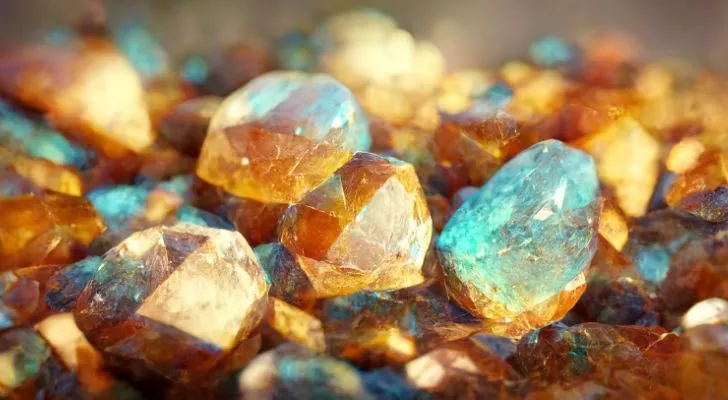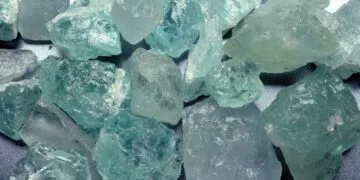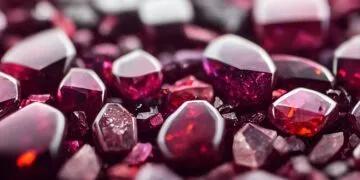November originally had just one birthstone, topaz. However, in 1912, American jewelers introduced citrine to the modern list of birthstones as a more affordable alternative.
The truth is both of these gems are remarkable in their own way, and November babies are fortunate to have them. Some believe these stones hold special mystical powers and could help with healing, boost confidence, and attract prosperity.
Whether you share these beliefs or not, there’s no denying that these jewels are plain beautiful. And if you’re curious why November birthstones are special, hang around to find 20 cool facts about them.
Topaz belongs to the silicate gemstone family, along with other notable members like quartz and clay. It also contains aluminum and fluorine with the chemical formula Al2SiO4(F,OH)2.
Although blue topaz is the most common type, this gem comes in different colors. Other lesser-known varieties include red, orange, pink, purple, yellow, brown, and colorless.
Most blue topaz gems you’ll find today were treated to make the color more intense. This process involves blasting pale or colorless varieties of this stone with radiation and heat.
Topaz was named after the ancient Greek island of Topazios, where a greenish-yellow stone was discovered. But to everyone’s surprise, the gem found wasn’t topaz but peridot, and the island doesn’t have a speck of topaz.
Under long-wavelength ultraviolet light, topaz gives off a yellow or greenish glow. But not to worry, even though it can fluoresce, this stone is not radioactive.
Topaz is the official gemstone for two US states, Texas and Utah. Both states adopted this precious mineral as their respective state gems in 1969.
Topaz is easily electrified by heat or friction, so you can test for genuine topaz by rubbing it on a wool cloth. If it begins to attract small pieces of debris like dust, hair, or paper, there’s a good chance it’s a topaz!
On the Mohs scale of hardness, topaz ranks at number eight, only two places behind diamond, making it the hardest silica gem. Despite such a high hardness rating, topaz is quite fragile as it splits evenly along specific weak lines.
The El-Dorado Topaz holds the record for the world’s largest faceted gemstone. It was found in Brazil in 1984, weighing a whopping 81 pounds (37 kilograms). After cutting, it now weighs 31,000 carats – that’s a 13.7 lb (6.2 kg) gemstone!
November’s gemstones, yellow topaz and citrine, look so much alike that you could mistake one for the other. Despite their apparent similarities, both gems have completely different chemical and physical structures.
Citrine (SiO2) is the gold-colored variant of Earth’s second most abundant mineral, quartz. Silicone and oxygen are the primary chemical constituents of this stone, and iron impurities give it a brilliant yellow color.
The French word for lemon, “citron,” is where citrine gets its name because they have the same pale-yellow color.
Citrine naturally comes in yellow, but the exact shade may vary slightly and sometimes includes hints of brown and green.
Genuine citrine is rare to come by. It’s much easier to get dupes made from baked amethyst, topaz, smoky quartz, and even yellow glass.
Early Europeans believed strongly in the mystical powers of citrine. People wore trinkets made from this gemstone to ward off evil spirits and snake bites.
At 20,200 carats (that’s 8.9 lbs or 4 kg), the Malaga citrine is the largest faceted citrine in the world. Unearthed back in the 1980s, it took nearly thirty years just to find the right team to cut it to shape.
Citrine is the gemstone for celebrating the 13th wedding anniversary, while topaz is for the 23rd.
Beautiful citrine gems have been used since 300 and 150 BC as decorative ornaments in ancient Greece. 17th-century Scottish soldiers also used them to adorn the handles of swords and daggers.
Besides making breathtaking jewelry, citrine may also be used in heat-resistant insulation for furnaces. It can withstand temperatures up to 752 to 842 degrees Fahrenheit (400 to 450 degrees Celsius).
Ancient Chinese emperors loved their citrine jewelry. They believed that it gave them wisdom and increased their intellectual abilities.

Those with November birthdays have two incredibly gorgeous gems to choose from.
The first is the luxurious topaz, known for its brilliant blue color but comes in just about any shade.
Then there’s the fiery citrine that brings a cheerful charm, perfect for the sunny energy of those born in November.
Both of these gems also symbolize success, happiness, and loyalty.


















